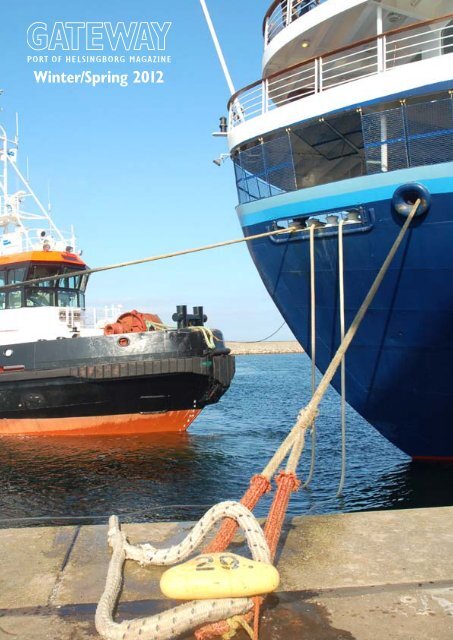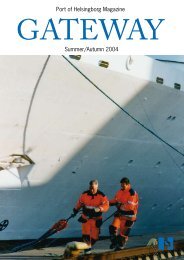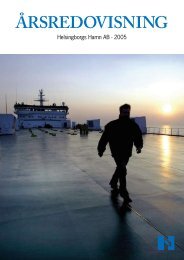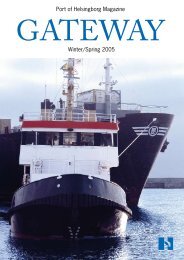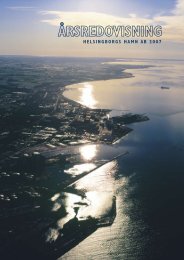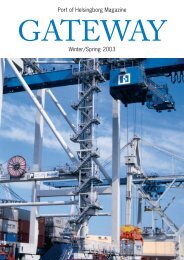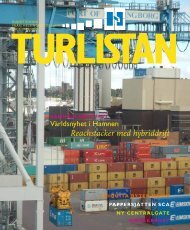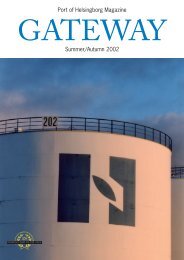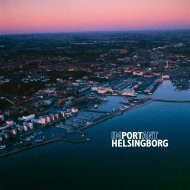Loaded & Unloaded - Helsingborgs Hamn AB
Loaded & Unloaded - Helsingborgs Hamn AB
Loaded & Unloaded - Helsingborgs Hamn AB
Create successful ePaper yourself
Turn your PDF publications into a flip-book with our unique Google optimized e-Paper software.
Winter/Spring 2012
2<br />
The Port of Helsingborg continues to grow<br />
Photo: Bertil Hagberg<br />
The year 2011 started very strongly and we<br />
gained new market shares. Container volumes<br />
by sea increased by 19 per cent based on the<br />
whole year, which was much more than for our<br />
main competitors. We regard this as proof that<br />
our customers appreciate the quality and service<br />
that the Port of Helsingborg provides.<br />
This is reflected in the SCI survey (satisfied<br />
customer index) that we performed in December.<br />
Overall, results were very positive. I would<br />
like here to thank everyone who took part<br />
in the survey. The information we received is<br />
incredibly valuable for us, giving new impulses<br />
and ideas about how we can continue to improve<br />
our operations.<br />
The shipping industry has rarely been so<br />
marked by such uncertainty as at present.<br />
Quite naturally, the financial crisis is affecting<br />
our market as it affects others too, which we<br />
noticed during the fourth quarter of last year.<br />
But in spite of this we had a positive start to<br />
this year as regards container and trailer operations.<br />
Now we are hoping that this is a trend<br />
that will continue. New market shares are a<br />
prerequisite for being able to develop the port<br />
facility.<br />
There is also a certain uncertainty about the<br />
future as regards to laws and regulations. From<br />
2015, there will be new IMO requirements for<br />
ships operating in the SECA area, involving a<br />
sulphur content of max. 0.1 per cent in fuel,<br />
compared to the present 1.0 per cent. There<br />
are numerous views about how this will affect<br />
the industry. We are planning to establish an<br />
LNG hub in the Port of Helsingborg. We have<br />
applied for and received EU grants for starting
The Port of Helsingborg from the north.<br />
a preliminary study and market analysis. The<br />
LNG project, called HELGA, is being run by the<br />
Port of Helsingborg, the Ports of Sweden, Energigas<br />
Sverige, NSR, Öresundskraft and Kemira.<br />
The question of how the Port of the future will<br />
look, taking into consideration how the city<br />
development project H+ progresses, is also important.<br />
There is no doubt, however, that the<br />
Port’s role as a motor for business and industry<br />
in the Helsingborg region will continue to be<br />
important. The key to success is finding a good<br />
way to co-exist, side by side. We will soon be<br />
Jo Kristian Okstad, CEO, the Port of Helsingborg.<br />
able to study the four contest proposals for<br />
the New West Harbour’s reconstruction and<br />
development. It will be very exciting to see the<br />
new ideas that the contesting teams present.<br />
Ideas that hopefully will lay the foundations of a<br />
new, modern, effective container terminal. The<br />
intention is that we will then supplement these<br />
proposals with financial analyses and a risk<br />
assessment so that we have comprehensive<br />
documentation to present to our owners, the<br />
City of Helsingborg, in the autumn.<br />
Finally, I would like to encourage everyone to<br />
test Scandlines’ newly renovated ferries. There<br />
is now very good reason to take a trip on the<br />
HH route. Jo Kristian Okstad, CEO, the Port of<br />
Helsingborg.<br />
3
4<br />
110,000 tonnes fruit and veg – 2011<br />
was a record year!<br />
The Port of Helsingborg is the Nordic region’s largest port for<br />
the direct import of fruit and vegetables. This was indisputable<br />
in 2011: a total of 6,000 containers of fresh fruit and vegetables<br />
passed through the Port.<br />
Mats Jakobsson, Purchasing Manager Fruit, ICA Göran Kollberg, Purchaser, Everfresh.<br />
Johan Åkesson, Purchasing Manager, Ewerman.<br />
Most of the major Swedish import<br />
companies have chosen Helsingborg<br />
as their logistics hub. There are many<br />
reasons for this, such as the Port’s<br />
unique location, a generous choice of<br />
shipping lines and an effective Combiterminal.<br />
In addition, it is much quicker<br />
to use the train than to ship the goods<br />
round the coast to Stockholm!<br />
New type of cooperation<br />
”Until a couple of years ago, pallets of<br />
fruit were stripped from the containers<br />
and placed in the Port’s refrigerated<br />
warehouse,” explains Kjell-Åke<br />
Ranft, the Port’s sales manager. ”The<br />
Port acted as transit storage. Now the<br />
importers have their own refrigerated<br />
facilities outside the city. We unload<br />
containers to the quay and customers<br />
collect them. The extra service we<br />
provide is to connect power to the refrigerated<br />
containers while they await<br />
collection. Bananas are a special case;<br />
they also require weighing.”<br />
More fruit when times are good<br />
We munched our way through large<br />
quantitities of clementines, bananas<br />
and apples last year. But considering<br />
the global financial situation at the<br />
end of the year, consumption ought<br />
to have stagnated. The fact is that the<br />
economic situation reflects the volumes,<br />
with a certain delayed effect.<br />
“The Port of Helsingborg dominates<br />
the fruit side completely”<br />
The ICA giant is far and away the<br />
biggest importer, volume-wise. Practically<br />
no vegetables come to the<br />
Port of Helsingborg, but considerable<br />
amounts of fruit. Apples and pears<br />
from Chile and Argentina represent<br />
the biggest volumes. Kiwi and grapes<br />
are imported from South America.<br />
The USA is a major pear country too.<br />
Almost all citrus fruits come from<br />
South America, apart from the large<br />
amounts of clementines coming from<br />
Morocco in the winter.<br />
The fruit is transported from the Port<br />
up to ICA’s huge warehouses outside<br />
Helsingborg. In addition, ICA has three<br />
distribution warehouses: in Kungälv,<br />
Stockholm and Borlänge. The fruit<br />
is taken by road from the warehouses<br />
up to the most northern areas of the<br />
country. Handling is quick; the driver<br />
is swapped and the lorries run constantly.<br />
”In the long term, we will see steady<br />
growth and our volumes will develop<br />
in a positive direction in the coming<br />
years,” says Mats Jakobsson, Purchasing<br />
Manager Fruit, ICA. ”We are<br />
continually looking at new solutions,<br />
including the possibility of using the<br />
Port more. The Port of Helsingborg<br />
has been expanding for a number of<br />
years now.”<br />
“Absolutely, we can envisage more<br />
collaboration”<br />
”All fruit and vegetables that we bring
into Sweden in containers arrives<br />
at the Port of Helsingborg,” says Johan<br />
Åkesson, Purchasing Manager at<br />
Ewerman, and tells us that Ewerman is<br />
part of STC GreenFood, which is the<br />
largest independent player in the field<br />
of fruit and vegetables in the Nordic<br />
region.<br />
Ewerman takes in more fruit than vegetables<br />
to the Port of Helsingborg.<br />
Of vegetables, it is onions from New<br />
Zealand that are the major product.<br />
The company imports apples, pears,<br />
grapes and stone fruits from South<br />
American countries such as Chile,<br />
Argentina and Uruguay. Fruit is also<br />
imported from South Africa, New<br />
Zealand, China and Morocco.<br />
The products from Europe are transported<br />
mainly by lorry.<br />
”Yes, we could definitely see ourselves<br />
having more collaboration with<br />
the Port of Helsingborg and taking in<br />
more fruit via the Port,” says Johan<br />
Åkesson. ”We have, for example, considered<br />
taking in bananas via Helsingborg<br />
with a call of our own. Our bananas<br />
come at present via Gothenburg<br />
or by lorry from the continent. Now<br />
that Helsingborg is an authorised<br />
weigher of bananas, we can take in<br />
bananas directly via the Port. What’s<br />
more, CMA CGM has a major project<br />
for operating ships with citrus fruits<br />
from Spain. We think that sounds interesting<br />
too.”<br />
Pink Lady, Granny Smith and 48<br />
more sorts<br />
”We sell between 1,000 and 2,000<br />
tonnes of fruit and veg a day and have<br />
a total of 800 different articles,” says<br />
Göran Kollberg, purchaser at Everfresh.<br />
”For instance, we have about<br />
50 different kinds of apples and about<br />
60 of tomatoes. The countries of<br />
growth for the different articles vary<br />
according to the season. Apples can<br />
come all the way from New Zealand,<br />
from Italy or even from the local orchard<br />
in Ramlösa. More or less all the<br />
fruit to Sweden from the southern<br />
hemisphere passes through the Port<br />
of Helsingborg. Volumes for the spring<br />
are booked with the shipping lines in<br />
December but usually have to be adjusted<br />
due to harvest outcomes in different<br />
countries.<br />
”The Port of Helsingborg is the biggest<br />
hub by far in Sweden,” says Göran<br />
Kollberg. From here we distribute<br />
directly to the whole of Sweden.”<br />
5
6<br />
Excellent boost for PortIT logistics system<br />
Kristina Ahlberg, project leader, Inport<br />
The Port of Helsingborg was proud to be the first port in Sweden<br />
to develop and install the PortIT system. PortIT is an internetbased<br />
system that allows customers and the Port to trace and<br />
track containers - in real time. The new generation is now here:<br />
PortIT 8.<br />
Using wireless communication between<br />
trucks, handheld terminals and<br />
the Port’s IT system, information is<br />
sent the moment a container is moved.<br />
The information is shown simultaneously<br />
on the Port’s website,<br />
where customers who are logged in<br />
can track their containers. The right<br />
information at the right time makes<br />
planning for deliveries much easier for<br />
consignors as well as consignees.<br />
New opportunities with no. 8<br />
PortIT 8 was launched in November.<br />
Apart from the technology having<br />
been renewed to meet future<br />
demands for effective solutions, the<br />
graphic presentation has also been<br />
much improved. All views are now<br />
clearly presented. ”Calls” show which<br />
quays are occupied, and “Containers”<br />
shows loading and unloading plans.<br />
Under this heading you can also see<br />
exactly where the container is standing,<br />
and select according to “Hazardous<br />
goods”, “Damage” etc. Under<br />
“Warehouse hotel” you can see the<br />
location in the warehouse or loading<br />
area. The vessels reporting system<br />
FRS and the Automatic Identification<br />
System (AIS) can be connected to<br />
“Calls”, making it possible to identify<br />
vessels.<br />
EDI and BI make the job easy<br />
Communication between the Port<br />
and our customers is of utmost importance.<br />
To make the day-to-day<br />
work easier and to reduce leadtimes<br />
and sources of error, structured information<br />
is transferred by Electronic<br />
Data Interchange (EDI) according to<br />
an agreed format. A business intelligence<br />
(BI) tool can also be integrated<br />
into PortIT 8, for analysis or decision<br />
support. The solution can be applied<br />
to everything that is measurable, such<br />
as TEUs over quay this year compared<br />
to last.<br />
Easier to pick up and deliver containers<br />
Advance notification of a visit to the<br />
Port can be given under “Advance<br />
Notification Gate”. Drivers who notify<br />
in advance make their own job<br />
easier, as well as ours. Anyone giving<br />
advance notification gets container<br />
status information, thus avoiding unrealised<br />
pickups/deliveries.<br />
Kristina Ahlberg, projektledare, Inport<br />
The Port owns the system<br />
The Port’s IT system Port IT has been<br />
developed in cooperation with Inport<br />
<strong>AB</strong> in Karlstad. The Port of Helsingborg<br />
has owned Inport <strong>AB</strong> since the<br />
turn of the year 2010/11.<br />
”We regard our owners very positively.<br />
They are very committed and give<br />
us excellent opportunities for developing<br />
PortIT,” says Kristina Ahlberg,<br />
project leader at InPort. ”But we’re<br />
careful about keeping the roles of owner<br />
and customer separate. When Inport<br />
acts at the Port, we are 100 per<br />
cent in the role of supplier.”<br />
PortIT 8 under way<br />
”We will be phasing the new system<br />
into operations successively,” says<br />
head of stevedoring Johan Ullenby.<br />
”But Inport are doing trials first, in a<br />
test environment, and these will be<br />
assessed. The new PortIT must function<br />
perfectly in order to make things<br />
easier for us and for our customers.<br />
If everything goes according to plan,<br />
version 8 will be under way in the first<br />
quarter of 2012.”
Helsingborg quarantine port<br />
Helsingborg’s border inspection post is one of Sweden’s most<br />
modern. It has been specially designed with three hygiene zones<br />
in order to meet the EU’s and Swedish authorities’ strict hygiene<br />
requirements. The premises now have an additional area of use:<br />
as a quarantine facility.<br />
The new border inspection post in the West Harbour.<br />
The Port of Helsingborg has been<br />
appointed a quarantine port, one of<br />
ten in Sweden. This means that if we<br />
get a call from a ship’s captain saying<br />
that there is an infectious disease on<br />
board, we have a duty to allot them<br />
a berth. Quite simply, we are not allowed<br />
to refuse them.<br />
Perfect premises!<br />
The Port already has premises that<br />
are suitable for quarantine. In fact, the<br />
premises couldn’t be better.<br />
”The border inspection post has three<br />
hygiene zones,” explains Christer<br />
Nilsson, who is environmental coordinator<br />
for the Port. ”Each part has<br />
a completely separate ventilation system<br />
to prevent the risk of infection<br />
spreading. Ventilation is extremely<br />
important with regard to infections<br />
and epidemics, and the infection control<br />
practitioner thought the premises<br />
were perfect.”<br />
Border inspection is interrupted temporarily<br />
in emergencies, and the premises<br />
are converted into quarantine.<br />
An infection control practitioner is<br />
contacted and comes to the Port. The<br />
vessel is then taken to a special berth<br />
from where the crew can be taken to<br />
the premises. There is always a doctor<br />
on call in the region for this purpose.<br />
Stay on board please<br />
”It is of course best if those infected<br />
stay on board,” says Christer Nilsson,<br />
”but if the disease is serious they can<br />
be taken ashore. First they are taken<br />
to the Port premises and then possibly<br />
to the Infections Clinic at the<br />
Helsingborg General Hospital. So far,<br />
thankfully nothing has happened, but<br />
when bird flu prevailed we were on<br />
full alert and went out with information.”<br />
There must be a plan<br />
In addition to providing premises, the<br />
Port has a duty to draw up a plan to<br />
prevent any infection from spreading.<br />
A completely new infection control<br />
plan, compiled by the Port of Helsingborg<br />
together with the City of Helsingborg,<br />
Region Skåne and infection<br />
control practitioners, will be determined<br />
shortly. This deals with berth,<br />
quarantine premises, cordoning off,<br />
procedures, chain of alarm and checklists.<br />
Christer Nilsson, Environment Coordinator,<br />
the Port of Helsingborg.<br />
The infection control practitioner and<br />
the City bear the main responsibility.<br />
If an emergency situation does arise,<br />
they are the ones who must ensure<br />
complete decontamination, such as of<br />
every single piece of luggage on the<br />
ship.<br />
Cruise with many infected passengers<br />
”The cruise ships are efficient and<br />
always isolate their patients quickly,”<br />
explains Christer Nilsson. “They also<br />
alter their destinations if there is infection<br />
at a port of call. They cannot afford<br />
risking the ship being put in quarantine.<br />
A vessel normally has a crew<br />
of 30–40, and we can cope with that<br />
in the Port. But if a whole cruise ship<br />
were to be subjected to infection, the<br />
passengers would have to be evacuated<br />
to other premises such as a military<br />
site.”<br />
The Port of Helsingborg is a very important<br />
pawn in the game. Our port is<br />
well suited to being a quarantine port<br />
on account of its strategic location<br />
halfway along the strait.<br />
7
New, effective handling system with<br />
straddle carriers<br />
A completely new handling system is to be tested<br />
and assessed at the Port. Five used straddle carriers<br />
have been bought from Bremerhaven for the purpose.<br />
Using these trucks, handling of containers can<br />
hopefully be rationalised considerably.<br />
”The purchase of the straddle carriers<br />
enable us to study their use as part<br />
of the continuing process of developing<br />
the port,” says Bengt Niklasson,<br />
Technical Manager at the Port. ”We<br />
are ensuring that the Port of Helsingborg<br />
will continue to be the customers’<br />
natural choice. Rational container<br />
handling is one of our concepts for<br />
success.”<br />
250 per cent better!<br />
One great advantage of handling containers<br />
with straddle carriers is that<br />
the containers can be placed more<br />
closely, providing more space in a given<br />
area. The containers are placed<br />
in rows, forming a passage one-anda-half<br />
metres wide between the rows.<br />
The width is currently much greater.<br />
This means in theory that we can increase<br />
our storage capacity by 250<br />
per cent.<br />
Compared to reach stackers, straddle<br />
carriers do not need the same turning<br />
radius and therefore do not need as<br />
much space to do their job. In addition,<br />
the lifting height makes it possible<br />
to lift a container over three stacked<br />
containers, i.e. a total of four containers<br />
high.<br />
Good value trucks<br />
”When we got the chance to buy five<br />
trucks at a price of less than what half<br />
a new truck costs, we took it of cour-<br />
8<br />
se,” says Bengt Niklasson.<br />
”We acted fast<br />
and placed an order<br />
before anyone else<br />
had the time to react.<br />
The trucks are of the<br />
Noell make and were<br />
supplied with newly<br />
renovated engines.<br />
One reason for the<br />
very good price is that<br />
no direct aftermarket<br />
exists as most ports<br />
buy in new trucks.”<br />
Training for Port<br />
truck drivers<br />
The straddle carriers<br />
were sent by barge<br />
from Bremerhaven<br />
and arrived at the<br />
Port of Helsingborg<br />
in December. Before<br />
delivery was made,<br />
a group of Port staff<br />
went to Bremerhaven<br />
for training and test<br />
driving. To be able to<br />
drive operatively, 6 -<br />
8 weeks’ training per<br />
driver is required.<br />
’Hamlet’ sails for Elsinore.
Bengt Niklasson, Technical Manager, the Port<br />
of Helsingborg.<br />
Straddle truck, Noell<br />
Max. height is just over 15.5 m.<br />
Max. speed 24 km/h<br />
Outer turning radius 9.6 m.<br />
Lifting capacity 40 tonnes, single lift<br />
Weight with lifting yoke about 57 tonnes<br />
Diesel-electric operation, driving motor Mercedes Benz<br />
Electric steering system, Siemens Simatic S7 system<br />
Lifting height 4 containers high, about 10 m.<br />
The Port of Helsingborg’s straddle carriers in Bremerhaven. When they were delivered to us they had been painted “Port blue”.<br />
9
10<br />
Åsa Solgevik new HR manager at<br />
the Port of Helsingborg<br />
The Port of Helsingborg has<br />
recruited Åsa Solgevik as new<br />
HR Manager. Åsa started the<br />
job on 5 December, having<br />
come to the Port from a position<br />
as personnel manager at<br />
Lappland Resorts <strong>AB</strong>.<br />
The recruitment of a new Human<br />
Resources manager at the Port of<br />
Helsingborg further increases our<br />
drive in the personnel area. During<br />
recent years, the CEO has had overall<br />
responsibility for personnel, and<br />
ongoing matters have been handled<br />
by department managers. The Port is<br />
now structuring its work in this area<br />
for the benefit of all its employees, for<br />
the sake of its development and of its<br />
attraction as an employer.<br />
Clear personnel structure<br />
”In a knowledge-intensive business<br />
like the Port, it is important to take<br />
advantage of all the existing expertise<br />
and to help to develop the employees<br />
even further. I’m looking forward to<br />
creating a clear personnel structure<br />
and to being able to support management<br />
and staff alike in their day-today<br />
work. But it is also important to<br />
draw up a long-term plan for how the<br />
personnel function can strengthen<br />
the company and make it even more<br />
attractive as a workplace,” says Åsa<br />
Solgevik, new HR Manager at the Port<br />
of Helsingborg.<br />
Solid personnel training<br />
Åsa Solgevik has solid personnel training<br />
and experience of HR matters<br />
31 years old, born and bred in Växjö.<br />
Trained occupational therapist, studied human<br />
work science at Umeå University.<br />
Has worked on HR (human resources) projects at<br />
different companies in Stockholm. Has had ongoing<br />
responsibility for personnel, recruiting, personnel<br />
care and policy matters, and responsibility during<br />
organisational changes at several large companies<br />
throughout Sweden.<br />
Likes to bake, cook and socialise.<br />
Loves exercise: gym, runs, skis, hikes and kitesurfs.<br />
Wants to get keep-fit activities going at the Port.<br />
Partner of Gustav who, rather suitably, is manager<br />
at Stadium sports shop.<br />
from managerial jobs at several large<br />
companies, and she will now be HR<br />
Manager at one of Sweden’s largest<br />
ports, with 260 employees.<br />
”It is important for the Port to be<br />
strengthened from within. Apart from<br />
the Port itself, our employees’ expertise<br />
is our most important asset. By<br />
focusing on strategic HR work, we develop<br />
our employees and strengthen<br />
the Port’s competitiveness on a market<br />
that is under tough pressure,” says<br />
Jo Kristian Okstad, CEO at the Port of<br />
Helsingborg.
SCI shows we’re on the right track<br />
As part of our quality and environment<br />
work we asked our<br />
customers to complete a questionnaire.<br />
We have now compiled<br />
our satisfied customer<br />
index, SCI.<br />
”I’m pleased about the result of the<br />
survey and think we got good response<br />
with a good result this year,”<br />
says Andréas Eriksson, Marketing and<br />
Information Manager at the Port.<br />
”But we are of course always striving<br />
to improve, and we really do pay attention<br />
to what our customers think.<br />
The answers in the SCI provide us<br />
with important information about<br />
More rail shuttles are wanted.<br />
Marketing & Information Manager<br />
Andréas Eriksson.<br />
how the Port functions today, but<br />
perhaps mainly with guidance as to<br />
what we can improve. We are dependent<br />
on our customers - thanks<br />
to them we have a port and a job.”<br />
Wishes become concrete initiatives<br />
The customers’ opinions are very<br />
valuable for the improvement of our<br />
customer service. One of the viewpoints<br />
that emerged from the survey<br />
was that “we would like to see more<br />
rail shuttles”. We can now say that<br />
we have started a rail campaign to<br />
increase the number of shuttles from<br />
the Combiterminal. There were<br />
also requests for “more information<br />
about who among the staff does<br />
what”. We will soon be launching a<br />
new website in order to improve our<br />
accessibility and make it easier to find<br />
the right person for providing quick<br />
answers and correct information.<br />
Becoming even better<br />
”We mustn’t forget that the existing<br />
choices are extensive and that there<br />
are many ports competing,” says Andréas<br />
Eriksson. ”One comment in the<br />
survey takes this up. ’In the expansive<br />
phase in which the Port of Helsingborg<br />
finds itself, it is important not to<br />
lose the advantages of a small port<br />
and to demonstrate flexibility and to<br />
be alert to our requirements.’ We regard<br />
this as an important point, but it<br />
also corresponds well with our vision<br />
’Your best business partner - now<br />
and in the future’. We will be performing<br />
a new SCI at least once a year<br />
to follow up our work. The challenge<br />
is to move the result to even more<br />
positive figures in the next SCI.”<br />
11
12<br />
<strong>Loaded</strong> & <strong>Unloaded</strong><br />
It is now MSC’s vessel ”Athens Trader” that calls at the West Harbour once a week to load and unload containers. The ship is seen here at quay 904.<br />
Another line that operates via the Skåne Terminal is Team Lines. The vessel “Alster” at crane 20 on quay 705 is seen here loading and unloading<br />
containers. Team Lines clear the ships themselves.
The Icelandic Eimskip line calls at the West Harbour once a week. The photo shows one of their vessels “Dettifoss”.<br />
<strong>Loaded</strong> & <strong>Unloaded</strong><br />
Maersk’s vessel “Kornett” is seen here at quay 906 and cranes 18 and 19 in the West Harbour, loading and unloading containers. Maersk Broker<br />
Agency clears the ships.<br />
13
14<br />
Project contest for the New West Harbour<br />
under way<br />
The following teams have advanced to<br />
the West Harbour project contest.<br />
Ramböll Sverige <strong>AB</strong>, Hamburg Port<br />
Consultans HPC, Liljewall Arkitekter<br />
COWI <strong>AB</strong>, Wingårdhs, SSPA, Seaport<br />
Group<br />
WSP Sverige <strong>AB</strong> & WSP Africa Coastal<br />
Engineers, Wåhlin Arkitekter <strong>AB</strong><br />
Arkitektfirmaet C.F. Möller A/S, Berg<br />
Arkitektkontor <strong>AB</strong>, Haskoning Nederland<br />
B.V.<br />
The contest got under way at the<br />
beginning of December, when the<br />
contestants were given a presentation<br />
of the Port of Helsingborg.<br />
The competing teams will each be<br />
paid SEK 500,000 when they submit<br />
an approved proposal. Any contestant<br />
revealing their identity before the<br />
winner is chosen will be disqualified.<br />
The contest is subject to the Swedish<br />
Public Procurement Act.<br />
We have an agreeable problem: Pressure<br />
is high on the Port of Helsingborg,<br />
and market shares are increasing<br />
continuously. But the problem is that<br />
the Port’s infrastructure is not ideal.<br />
For future growth and to increase our<br />
profitability in the long term, we have<br />
to effectivise the Port site. This was<br />
the reason for initiating a project contest<br />
with the goal of developing and<br />
rebuilding the West Harbour.<br />
The project contest for the New<br />
West Harbour includes several stages.<br />
The first was pre-qualification, with<br />
interested parties submitting their<br />
tenders. On the basis of the tenders,<br />
four teams have been chosen, each<br />
with the chance to propose a design<br />
for the future layout of the Port. The<br />
four entries will be displayed at an exhibition<br />
in May.<br />
The assignment is to design the West<br />
Harbour as a modern container terminal<br />
with the capacity to cope with<br />
Oskar Jonsson, CEO assistant, the Port of<br />
Helsingborg<br />
”To enable growth with good profitability<br />
over the next 20 years, it’s<br />
important to start the work now<br />
on developing the Port’s operations.<br />
The project contest is not only exciting<br />
but is also an important step<br />
forward in the development of the<br />
city’s port.”<br />
Jo Kristian Okstad, CEO, the Port<br />
of Helsingborg.<br />
20-30 years of volume development.<br />
The contestants have to present suggestions<br />
for a new gate for use by all<br />
traffic, design a new quay and effectivise<br />
the logistics in and between the<br />
terminals. There are strict demands<br />
for making effective use of space, with<br />
solutions compatible with the surrounding<br />
environment.<br />
Wanted: expert team for complex<br />
task<br />
The contest is open for interested<br />
firms in the fields of architecture, construction,<br />
logistics and effectivisation,<br />
machine construction and with nautical<br />
connections.<br />
Preliminary qualification was completely<br />
open so that anyone could<br />
present a tender. The conditions and<br />
rules of the contest were entered in<br />
a procurement database published in<br />
the whole of the EU. Information was<br />
also distributed in press releases and<br />
via our website.<br />
Marketing & Information Manager Andréas<br />
Eriksson.<br />
Jo Kristian Okstad, CEO, the Port of<br />
Helsingborg.<br />
Where are they all?<br />
November 11 was the final date for<br />
pre-qualification. On the 10th, only<br />
one tender had been submitted and<br />
some tension was felt in the Port office.<br />
Weren’t there any teams with the<br />
expertise we required? Hadn’t our<br />
information been clear enough? On<br />
the morning of 11 November things<br />
started moving and, at the end of the<br />
day, we had 14 high quality tenders.<br />
The final tender arrived by car at the<br />
last minute.<br />
”We hoped that some teams with<br />
the expertise we require would show<br />
an interest, and they did,” says Oskar<br />
Jonsson, CEO-assistant at the Port<br />
of Helsingborg and project coordinator<br />
for the contest. ”It was mainly<br />
Swedish companies who submitted<br />
tenders, with cutting-edge expertise<br />
taken in from Sweden and abroad. A<br />
total of 14 qualified tenders for this<br />
extremely complex task is excellent.”
Detailed documentation<br />
The programme governing the contestants’<br />
work has been drawn up<br />
in minute detail. It says exactly how<br />
the entries are to be composed and<br />
presented. This is so that all the contestants<br />
have the same starting point<br />
and can be judged fairly on the same<br />
grounds. The entries will be completely<br />
anonymous.<br />
”It’s a challenge for us at the Port to be<br />
specific, controlling detail, while also<br />
encouraging creativity,” says Andréas<br />
Eriksson, Marketing and Information<br />
Manager at the Port. ”Naturally, we<br />
are experts in our own field and have<br />
an idea of how we want things. But<br />
at the same time we want to broaden<br />
our view and we value an input<br />
of new ideas.<br />
”We intend to continue working with<br />
the winning team in order to develop<br />
a proposal that we can submit to our<br />
owners, the City of Helsingborg, for<br />
evaluation. The teams see ports from<br />
a general perspective. We are experts<br />
on our particular port, not least<br />
in relation to economy and profitability.<br />
One of the major challenges will<br />
also be to perform construction while<br />
the day-to-work continues in parallel.”<br />
Planning for the future<br />
On the basis of our estimates as well<br />
as those of the industry as a whole,<br />
long term growth in the area of container<br />
handling will be about five per<br />
cent a year. Rebuilding the West<br />
Harbour is one of way of facing this<br />
trend and consolidating the Port of<br />
Helsingborg’s position as the Container<br />
Specialist. With good planning<br />
and clever logistics we will be able to<br />
handle increasingly large volumes in<br />
shorter times, multiplying capacity.<br />
”But our focus is of course always on<br />
our present customers. That’s way<br />
we’re not waiting for the project to<br />
start. We are continually creating<br />
The West Harbour from the air. Photo: Bertil Hagberg<br />
new areas, effectivising and making<br />
improvements,” concludes Andréas<br />
Eriksson.<br />
”To enable growth with good profitability<br />
over the next 20 years, it’s<br />
important to start the work now on<br />
developing the Port’s operations. The<br />
project contest is not only exciting but<br />
is also an important step forward in<br />
the development of the city’s port.”<br />
Jo Kristian Okstad, CEO, the Port of<br />
Helsingborg.<br />
15
16<br />
PO Jansson<br />
In 2009, a project to support shipping<br />
in the process of transferring to<br />
an alternative fuel - liquefied natural<br />
gas (LNG) was started. The project,<br />
called HELGA (Helsingborg Liquefied<br />
Gas Association), is run by the Port of<br />
Helsingborg, the Ports of Sweden, Energigas<br />
Sverige, NSR, Öresundskraft<br />
and Kemira. PO Jansson, former CEO<br />
of the Port of Helsingborg, was involved<br />
in the start-up and is now project<br />
leader for HELGA.<br />
LNG – an alternative shipping fuel<br />
”IMO’s decision that bunker oil may<br />
only contain 0.1 per cent sulphur<br />
creates problems,” says PO Jansson.<br />
“There’s good oil and there’s bad oil.<br />
We already use the best available oil<br />
in our ferries between Elsinore and<br />
Helsingborg. But really good oil is un-<br />
Liquefied natural gas<br />
Shipping is currently operated with conventional bunker oils. To<br />
protect the environment, the International Maritime Organization<br />
(IMO) has decided that vessels operating in the Baltic and<br />
North Sea must reduce their sulphur emissions to 0.1 per cent<br />
from the year 2015. As access to low-sulphur oil is limited, there<br />
is an urgent need for an alternative fuel. HELGA is a project for<br />
liquefied natural gas.<br />
What’s what?<br />
Natural gas and biogas consist mainly of methane. Natural gas is<br />
an imported fossil fuel. Biogas is a renewable fuel that is produced<br />
locally, usually by anaerobic digestion of waste.<br />
The gas that is usually used in vehicles is compressed. Compressed<br />
natural gas (CNG) or compressed biogas (CBG).<br />
Liquefied natural gas (LNG), liquefied biogas (LBG).<br />
The gas is liquefied when cooled to minus 162°C. On cooling, the<br />
volume decreases 600-fold. This means there is space for more fuel.<br />
NSR/Terracastus in Helsingborg is the world’s largest plant for<br />
upgrading methane gas to liquefied biogas (LBG). Three million lorries<br />
pass by Helsingborg every year. NSR will therefore be building<br />
a service station for LBG. In this system, LNG from the Port can be<br />
used if there is a shortage of LBG.<br />
fortunately hard to find, and prices are<br />
going to rocket. The Swedish export<br />
and import industries will incur increased<br />
costs on account of this. One<br />
alternative to bunker oil is liquefied<br />
natural gas (LNG). Natural gas is a<br />
fossil fuel, that’s true, but many people<br />
don’t see its advantages. LNG does<br />
not produce any sulphur emissions at<br />
all, and it is an existing fuel.”<br />
“Gas hub” in Helsingborg<br />
The HELGA project examines what<br />
possibilities there are for building a<br />
service station and storage facility for<br />
liquefied natural gas and biogas within<br />
the Kemira site.<br />
”We will be importing gas from suitable<br />
countries,” explains PO Jansson.<br />
”The liquefied gas will arrive by<br />
sea. The Port of Helsingborg has a<br />
unique location - 50,000 vessels pass<br />
here every year, as well as three million<br />
vehicles. This is a volume of traffic<br />
that provides an excellent base for the<br />
operations.”<br />
The waters outside Helsingborg are<br />
one of the world’s busiest fairways. It<br />
is therefore logical to locate a service<br />
station at a point the ships are passing<br />
anyway. In addition, the Port has a natural<br />
deep dock that allows vessels to<br />
go and refuel. LNG can be used as a<br />
complement to liquefied biogas (LBG)<br />
for heavy road traffic. In addition to<br />
a service station for shipping and for<br />
heavy traffic, a pipe for industrial gas<br />
can be built.
-a contemporary fuel<br />
Hot topic in Europe<br />
The question of finding an alternative<br />
to bunker oil is being driven hard in<br />
Europe. Finding an alternative fuel is<br />
therefore also of importance for the<br />
transport industry. Using LNG, you<br />
can reduce particles as well as nitrogen<br />
oxides (NOx) and sulphur oxides<br />
(SOx). The EU is encouraging more<br />
countries to apply for grants for making<br />
preliminary studies. Ten European<br />
ports have now applied for funds.<br />
HELGA applying for SEK 12 million<br />
HELGA has applied for EU grants for<br />
starting a preliminary study and market<br />
analysis. A survey is required, to<br />
review what is needed for building a<br />
plant in Helsingborg. The EU regards<br />
the opportunities for shipping to relieve<br />
the roads in Europe of traffic as<br />
of great importance and welcomes<br />
all related initiatives for improving the<br />
environment.<br />
”We think the EU will be pleased<br />
about our application,” says PO Jansson.<br />
”They can see now that things<br />
are starting to happen. We are now<br />
waiting for an answer. If we get approval<br />
we will have to pay 50 per cent<br />
ourselves, about SEK 6 million.”<br />
We must plan ahead<br />
”The work on HELGA is not being<br />
done solely to comply with the sulphur<br />
directive,” says PO Jansson. ”We<br />
have to develop alternative energy<br />
sources in time. We all know that<br />
the oil is going to dry up sometime.<br />
Svenska Petroleum & Biodrivmedelinstitutet<br />
(SPBI) say that the oil, with<br />
The ferries already have the best oil.<br />
today’s known deposits, will last for<br />
about another 40 years. Gas should<br />
last about 100. If oil and gas are combined,<br />
the oil will last longer. So there<br />
are suddenly two alternatives. Perhaps<br />
costs can even be kept down in<br />
the long term.<br />
”LNG is definitely a competitive fuel.<br />
The gas will have a good chance of being<br />
able to compete with bunker oil,”<br />
concludes PO Jansson.<br />
17
18<br />
Environmental work on all fronts in Port<br />
The Port has always worked actively on environmental issues.<br />
The work on reducing emissions to air and water, and noise, is<br />
continual. And it is satisfactory to say that the work does pay off.<br />
Removal of din-X cisterns.<br />
One good example is that the diesel<br />
consumption per handled TEU unit<br />
has decreased significantly since 2004.<br />
Carbon dioxide emissions have thus<br />
decreased to the same extent. Every<br />
time a container was moved in 2004,<br />
it took about 4 litres of diesel and<br />
10.75 kg of carbon dioxide was emitted.<br />
Now the corresponding amounts<br />
are 2.64 litres of diesel and 7.09 kg<br />
carbon dioxide.<br />
The change has been achieved by the<br />
Port improving, simplifying and effectivising<br />
its work. The mathematics<br />
are easy: a better flow means less fuel<br />
consumption. The work has involved<br />
minimising the number of lifts per<br />
container and finding ways of moving<br />
the containers over shorter distances<br />
to avoid driving them round the area.<br />
Onwards to gas!<br />
One part of the Port of Helsingborg’s<br />
systematic environmental work is to<br />
replace petrol and diesel fuelled passenger<br />
and transport vehicles with<br />
gas-powered. Of the Port’s total of 53<br />
cars, 10 are gas cars and four others<br />
eco-cars. We can also make a comparison<br />
here between different types<br />
of fuels and the amounts of carbon<br />
dioxide emissions. If you drive 10 km<br />
on diesel, the carbon dioxide emission<br />
is 2.98 kg. If the car is petrol fuelled,<br />
the emission is 2.65 kg/10 km. If you<br />
choose natural gas instead, only 1.12<br />
kg carbon dioxide is emitted. If it is<br />
possible to choose biogas, the level<br />
goes down to a mere 0.39 kg.*<br />
When calculating how environmentally<br />
harmful a vehicle is, the vehicle<br />
is usually seen from a life cycle perspective,<br />
taking the whole production<br />
chain into account. From raw material<br />
and production through to scrapping.<br />
As the declared carbon dioxide emis-<br />
sion does not show the whole climate<br />
impact, the life cycle perspective<br />
should be considered when choosing<br />
a vehicle.<br />
Port has own energy police<br />
The Port of Helsingborg has an energy<br />
saving group consisting of three<br />
experienced men. Christer Nilsson,<br />
Environment Coordinator, Bengt Niklasson,<br />
Technical Manager, and Heinz<br />
Somplatzki who is janitor. The group<br />
is also assisted by independent consultants.<br />
”We examine and review what is possible<br />
to improve,” says Christer Nilsson.<br />
”For instance, we try to phase<br />
out and replace old oil systems with<br />
air/water or air/air heat exchangers.<br />
There is now a new air/water heat<br />
exchanger in the workshop building<br />
instead of the old oil-fired boiler.
The SITA site. Three of the Port’s new gas-driven cars.<br />
Christer Nilsson, Environment Coordinator. Bengt Niklasson, Technical Manager. Heinz Somplatzki,<br />
Janitor.<br />
”We are also reviewing the lighting in<br />
the Port and will gradually be replacing<br />
it. But first we have to check the<br />
lamps’ function. They must not dazzle,<br />
but still provide sufficient light. The<br />
lamps must also be durable.”<br />
Demolition and cleaning up provide<br />
space<br />
The fuel companies in the Port cooperate<br />
in order to save resources.<br />
This means that they do not need all<br />
the areas that were at their disposal<br />
before. After cleaning up the areas<br />
will be taken over and used in the Port<br />
operations.<br />
Din-X has phased out its operations<br />
and removed its cisterns, and the<br />
ground has already been dealt with.<br />
Shell has shut and demolished its buildings<br />
and the ground is to be cleaned<br />
up. Even the SITA site, where there<br />
were oil cisterns from the early 1900s<br />
and, more recently, vehicle washing,<br />
has been cleaned up. The pollution<br />
has been removed and the ground<br />
will be hardened to cope with heavy<br />
reach stackers.<br />
Christer Nilsson says that all demolition<br />
and cleaning up is being done according<br />
to the book.<br />
”We have a comprehensive selfinspection<br />
programme to keep a<br />
check on the groundwater as there is<br />
ground that has long been contaminated<br />
within the port area. Our job<br />
is to ensure that pollution does not<br />
increase or spread.”<br />
Recycling with increasing costs<br />
Swedish ports are obliged by the State<br />
to receive sludge, oily engine-room<br />
waste, free of charge. The Port of<br />
Helsingborg receives about 2,000 m3<br />
per annum in its oil separation facility.<br />
After separation, the sludge is refined<br />
into fuel oil and is re-used in areas<br />
such as the cement industry. One<br />
growing problem, however, is that the<br />
vessels that deposit sludge also leave<br />
an increasing amount of water, which<br />
means that the Port has to transport<br />
a lot of water to the purification plant.<br />
”We have a new rule,” says Christer<br />
Nilsson. ”If the sludge contains 25 per<br />
cent water, we will make an extra<br />
charge. It will thus benefit ships to separate<br />
the oil from water before they<br />
transfer it to the Port of Helsingborg.<br />
* You can visit www.miljöfordon.se<br />
and see how eco-friendly your own<br />
car is.<br />
19
20<br />
Pirates – theme at security symposium in<br />
Saudi Arabia<br />
For the third time, the Ministry<br />
of the Interior and the Frontier<br />
Guard in Saudi Arabia arranged<br />
an international security<br />
symposium. The main focus<br />
was on a topical subject that<br />
attracts much attention: piracy<br />
in the Indian Ocean and Saudi<br />
Arabia’s shipping lanes. Issues<br />
discussed included whether<br />
merchant vessels should be allowed<br />
to have armed guards<br />
on board.<br />
Gathering knowledge<br />
and experience<br />
of security<br />
matters from other<br />
countries lies<br />
in the interests of<br />
the host country.<br />
Mats Rosander,<br />
Traffic Manager at<br />
the Port of Helsingborg,<br />
and also<br />
fire engineer, with<br />
his cutting-edge<br />
expertise in the<br />
field of security,<br />
was invited as a<br />
speaker. Other<br />
lectures during the<br />
symposium dealt<br />
with sea rescue<br />
and coastguard as<br />
well as how to act<br />
during rescues in<br />
sandstorms, which<br />
are in fact similar<br />
to snowstorms.<br />
”All ports must fulfil the global terrorist<br />
protection ISPS code - The<br />
International Ship and Port Facility<br />
Security Code,” says Mats Rosander.<br />
The Port’s Traffic Manager Mats Rosander was one of about 20 speakers.<br />
Port Inspector Karl Rosberg of the Transport Agency in conversation with Rear Admiral Awwad Eid Al-Balawi, responsible<br />
for the 3rd International Symposium on Maritime Disaster Management, his assistants and Traffic Manager Mats Rosander.<br />
”The symposium ended with a very<br />
realistic full-scale exercise with 600<br />
participants from the police, armed<br />
forces, frontier guard, health service<br />
and air force. As specially invited VIP<br />
guests, we were able to watch a pirate<br />
attack.”
Cruise vessels 2012<br />
Date Ship Time<br />
June 1 Star Flyer 10.00-18.00<br />
June 6 Grand Princess 07.00-16.00<br />
July 5 Caribbean Princess 07.00-16.00<br />
August 29 Grand Princess 07.00-16.00<br />
September 4 Ocean Countess 09.30-17.00<br />
2010 2011<br />
1/1-31/12 1/1-31/12 %<br />
Vehicles 2 191 302 2 064 217 -5,8<br />
Passengers 8 539 627 8 338 940 -2,4<br />
Cargo in tonnes 8 306 138 8 403 632 1,2<br />
21
22<br />
Per Anders Johansson, Maria Pingel, Stefan<br />
Henriksson, Li Thornberg, Kent Carlsson,<br />
Bring Frigo Overseas, and Erik Hansen CMA<br />
CGM Scandinavia AS.<br />
Roger Borggren, Eimskip Logistics, Magdalena Lindqvist, Gelita<br />
<strong>AB</strong>, Lena Borg, Eimskip Logistics, Mattias Hannen, Gelita <strong>AB</strong><br />
and Magnus Svensson, Eimskip Logistics.<br />
In the summer and autumn of 2011<br />
the following people and companies<br />
visited the Port of Helsingborg<br />
Lars Petersson, Lars Nolander, Tina Toft and<br />
Henrik Fälldin, SCA Transforest <strong>AB</strong>.<br />
Thorsteinn Bjarnarson, CEO Eimskip, Helsingborg and Åsbjörn Skulason,<br />
Eimskip Iceland.
Company: Telephone:<br />
+46<br />
Alianca Sweden 31 755 44 20<br />
ACL Sweden <strong>AB</strong> 31 645 500<br />
All in Shipping (Sweden) <strong>AB</strong> 42 13 13 15<br />
Aseco <strong>AB</strong> 31 743 77 00<br />
ZIM Agency in Sweden <strong>AB</strong> 31 719 44 00<br />
Citadel Shipping <strong>AB</strong> 42 13 90 75<br />
CMA CGM Scandinavia A/S 42 22 08 50<br />
Eimskip Island ehf, Filial Island 42 17 55 00<br />
Georg Hansen Shipping <strong>AB</strong> 31 704 14 00<br />
Globaltrans Logistics <strong>AB</strong> 42 24 25 30<br />
Hamburg Süd Norden <strong>AB</strong> 31 755 44 00<br />
Hansa Shipping <strong>AB</strong> 31 354 40 45<br />
Hapag-Lloyd (Sweden) <strong>AB</strong> 31 337 82 00<br />
Hecksher Linieagenturen <strong>AB</strong> 31 720 28 80<br />
Hyundai Merchant Marine<br />
(Scandinavia <strong>AB</strong>) 31 704 81 00<br />
”K” Line (Sweden) <strong>AB</strong> 42 33 65 50<br />
Lindholm Shipping <strong>AB</strong> 42 12 60 90<br />
Maersk Sverige <strong>AB</strong> 31 751 10 00<br />
Maritime Transport & Agencies <strong>AB</strong> 31 720 39 00<br />
Melship <strong>AB</strong> 42 13 73 20<br />
MOL (Europe) Nordic 31 335 05 40<br />
MSC Sweden <strong>AB</strong> 42 38 74 20<br />
NYK Line (Europe) Ltd. 31 31 704 54 00<br />
OOCL (Sweden) <strong>AB</strong> 31 335 59 00<br />
Overseas Liner Agency <strong>AB</strong> 31 743 01 80<br />
Panalpina <strong>AB</strong> 31 74 64 700<br />
Penta Shipping <strong>AB</strong> 31 704 24 60<br />
Scandlines <strong>AB</strong> 42 18 60 00<br />
SCA Transforest <strong>AB</strong> 60 19 35 00<br />
Scanway-Shipping <strong>AB</strong> 42 20 88 70<br />
Sundship 42 38 52 20<br />
Svenska Orient Linjen <strong>AB</strong> 31 354 40 30<br />
Transatlantic Southern Africa<br />
Services <strong>AB</strong> 31 354 40 00<br />
Transweco <strong>AB</strong> 31 703 78 00<br />
Team Lines <strong>AB</strong> 08 555 72 692<br />
TT-Line 410 56 000<br />
Unifeeder A/S 31 64 46 80<br />
United Arab Agencies <strong>AB</strong> 42 20 88 70<br />
United Arab Agencies 31 778 22 50<br />
Agents for Port of Helsingborg<br />
Telephone Telefax<br />
Belgium: Sundman, Brussel, Belgium + 32 (2) 345 76 90 + 32 (2) 345 76 90<br />
E-mail sundman@swing.be<br />
England: Eurolist International Ltd., London, England + 44(20) 7387 7300 + 44 (20) 7387 73 04<br />
E-mail bvdveurolistinternational.com<br />
Latvia: SIA LJS Hanza Ltd, Riga, Latvia. + 371 (7) 830 059 + 371 (7) 322 464<br />
Russia: Inflot JSC, St. Petersburg, Russia + 7 (812) 251 27 48 + 7 (812) 251 85 09<br />
USA: Transmar Ltd, Tiburon, California, USA. + 1 (415) 435 5833 + 1 (415) 435 5835<br />
Shipping Companies, Shipbrokers and Liner Agents<br />
23
Published by the Marketing Department Port of Helsingborg<br />
P.O. Box 821, SE-251 08 Helsingborg, Sweden. Phone: +46 42 10 63 00. Fax: +46 42 28 22 99.<br />
E-mail: information@port.helsingborg.se. Internet: www.port.helsingborg.se


